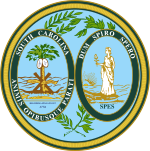1954 United States Senate election in South Carolina
| ||||||||||||||||
| ||||||||||||||||
 Thurmond: 50–60% 60–70% 70–80% 80–90%
Brown: 50-60% 60-70% >90% | ||||||||||||||||
| ||||||||||||||||
| Elections in South Carolina |
|---|
 |
The 1954 South Carolina United States Senate election was held on November 2, 1954. Senator
General election campaign
State Democratic Party executive committee
Sitting Senator
The state Democratic Party's decision to choose a candidate without holding a special primary election drew widespread criticism across the state. On September 3, The Greenville News ran an editorial advocating that a primary election be called and several newspapers across the state followed suit. At least six county Democratic committees repudiated the action by the state committee and called for a primary election. Despite repeated calls for a primary, the state executive committee voted against holding a primary because they did not think that there was enough time before the general election to hold a primary election.
Immediately after the executive committee voted against holding a primary election, former Governor Strom Thurmond and lumberman Marcus Stone announced their intention to run as Democratic write-in candidates. Thurmond and his supporters stated that the executive committee had several legal alternatives as opposed to the outright appointment of state Senator Brown. In addition, Thurmond promised that if he were elected he would resign in 1956 so that the voters could choose a candidate in the regular primary for the remaining four years of the term.
Campaigns of the candidates
Thurmond received support from Governor James F. Byrnes and from those who backed his Presidential bid as a Dixiecrat in the 1948 Presidential election. Thurmond framed the race as a "moral issue: democracy versus committee rule"[2] and his write-in campaign was repeatedly assisted by every newspaper in the state, except for those in Anderson. For instance, The News and Courier devoted its front page on November 2 to show voters a sample ballot and it also provided detailed instructions on how to cast a write-in vote. Not only that, but the newspaper also printed an editorial on the front page giving precise reasons why voters should vote for Thurmond instead of Brown.
On the other hand, Brown was supported by the Democratic party regulars and he also gained the endorsement of Senator Olin D. Johnston. Brown based his campaign entirely on the issue of party loyalty, stressing that Thurmond was a Republican ally because he had voted for President Eisenhower in 1952.
Marcus A. Stone, a lumberman in Florence and Dillon, was a candidate in previous Democratic primaries for governor and senator. He did very little campaigning for the general election.
General election results
| Party | Candidate | Votes | % | ±% | |
|---|---|---|---|---|---|
Democratic
|
Strom Thurmond (Write-In) | 143,444 | 63.13% | +63.1 | |
Democratic
|
Edgar A. Brown
|
83,525 | 36.76% | -59.6 | |
Democratic
|
Marcus Stone (Write-In) | 240 | 0.11% | +0.1 | |
| No party | Write-Ins | 23 | 0.01% | 0.0 | |
| Majority | 59,919 | 26.37% | -66.5 | ||
| Turnout | 227,232 | ||||
Democratic hold
| |||||
See also
- List of United States senators from South Carolina
- 1954 United States Senate elections
- 1954 South Carolina gubernatorial election
Notes
References
- "A New Test For S.C. Voters". The News and Courier. November 2, 1954. p. 1A.
- "Brown Faces Thurmond In Write-In Race". The News and Courier. November 2, 1954. p. 1A.
- Lander, Ernest McPherson Jr. (1970). A History of South Carolina, 1865-1960. University of South Carolina Press. pp. 182–184. ISBN 0-87249-169-2.
- "Supplemental Report of the Secretary of State to the General Assembly of South Carolina." Reports and Resolutions of South Carolina to the General Assembly of the State of South Carolina. Volume I. Columbia, SC: 1955, pp. 4–5.


